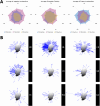Position-based assessment of head impact frequency, severity, type, and location in high school American football
- PMID: 39877265
- PMCID: PMC11772367
- DOI: 10.3389/fbioe.2024.1500786
Position-based assessment of head impact frequency, severity, type, and location in high school American football
Abstract
Introduction: Research on head impact characteristics, especially position-specific investigations in football, has predominantly focused on collegiate and professional levels, leaving a gap in understanding the risks faced by high school players. Therefore, this study aimed to investigate the effect of three factors-player position, impact location, and impact type-on the frequency, severity, and characteristics of impacts in high school American football. Additionally, we examined whether and how player position influences the distribution of impact locations and types.
Methods: Sixteen high school football players aged 14 to 17 participated in this study. Validated mouthguard sensors measured head impact kinematics, including linear acceleration, angular acceleration, and angular velocity across ten games, and were used to identify impact locations on the head. Video recordings verified true impacts, player position, and impact type at the moment of each recorded impact. Head impact kinematics were input into a head finite element model to determine the 95th percentile of the maximum principal strain and strain rate. Several novel and systematic approaches, such as normalization, binning, and clustering, were introduced and utilized to investigate the frequency and severity of head impacts across the three aforementioned factors while addressing some of the limitations of previous methodologies in the field. To that end, the number of recorded impacts for each player position during each game was divided by the number of players in that position, and then averaged across ten games. Instead of averaging, impacts were categorized into four severity bins: low, mid-low, mid-high and high. Clusters for the three factors were also identified according to the characteristics of impacts.
Results and discussion: Results revealed that offensive linemen and running backs experienced a higher normalized frequency and more severe impacts across all head kinematics and brain tissue deformation parameters. Frontal impacts, resulting from "head-to-head" impacts, were the most frequent and severe impact locations. The distributions of impact location and type for each specific position were distinct. Offensive linemen had the highest proportion of frontal impacts, while quarterbacks and centerbacks had more impacts at the rear location. These findings can inform interventions in game regulations, training practices, and helmet design to mitigate injury risks in high school football.
Keywords: brain tissue deformation; head impact frequency; head impact severity; head kinematics; high school football; mouthguards; sport-related concussion; traumatic brain injury.
Copyright © 2025 Bagherian, Abbasi Ghiri, Ramzanpour, Wallace, Elashy, Seidi and Memar.
Conflict of interest statement
The authors declare that the research was conducted in the absence of any commercial or financial relationships that could be construed as a potential conflict of interest.
Figures







Similar articles
-
Identifying Factors Associated with Head Impact Kinematics and Brain Strain in High School American Football via Instrumented Mouthguards.Ann Biomed Eng. 2021 Oct;49(10):2814-2826. doi: 10.1007/s10439-021-02853-5. Epub 2021 Sep 21. Ann Biomed Eng. 2021. PMID: 34549342 Free PMC article.
-
Frequency and location of head impact exposures in individual collegiate football players.J Athl Train. 2010 Nov-Dec;45(6):549-59. doi: 10.4085/1062-6050-45.6.549. J Athl Train. 2010. PMID: 21062178 Free PMC article.
-
Head impacts during high school football: a biomechanical assessment.J Athl Train. 2009 Jul-Aug;44(4):342-9. doi: 10.4085/1062-6050-44.4.342. J Athl Train. 2009. PMID: 19593415 Free PMC article.
-
Career Head Impact Exposure Profile of Canadian University Football Players.J Appl Biomech. 2022 Feb 1;38(1):47-57. doi: 10.1123/jab.2020-0228. Epub 2022 Jan 19. J Appl Biomech. 2022. PMID: 35045388
-
Frequency and Magnitude of Game-Related Head Impacts in Male Contact Sports Athletes: A Systematic Review and Meta-Analysis.Sports Med. 2019 Oct;49(10):1575-1583. doi: 10.1007/s40279-019-01135-4. Sports Med. 2019. PMID: 31175636
Cited by
-
Falling and Landing Framework (FLF): A Consensus on a Novel Falling and Landing Video Analysis Framework for Use Across Rugby Codes.Eur J Sport Sci. 2025 Aug;25(8):e70015. doi: 10.1002/ejsc.70015. Eur J Sport Sci. 2025. PMID: 40650431 Free PMC article.
References
LinkOut - more resources
Full Text Sources
Miscellaneous

